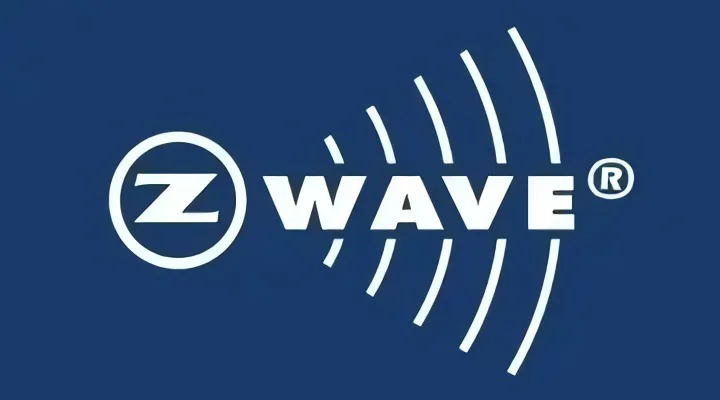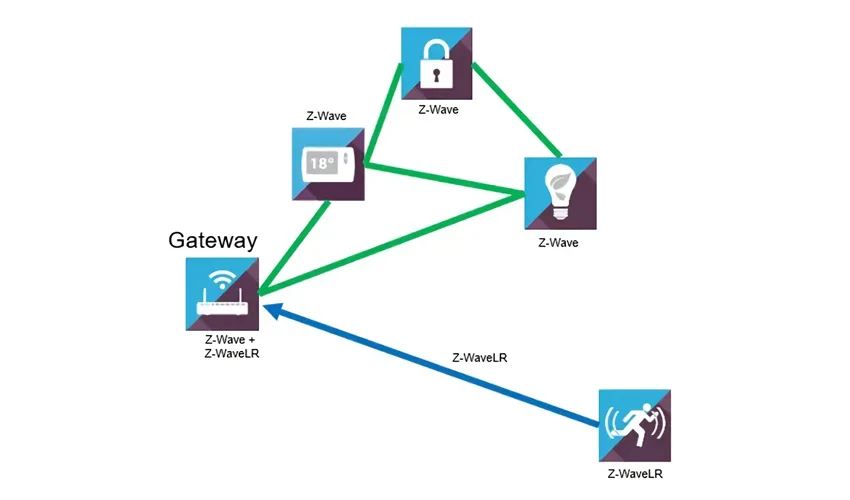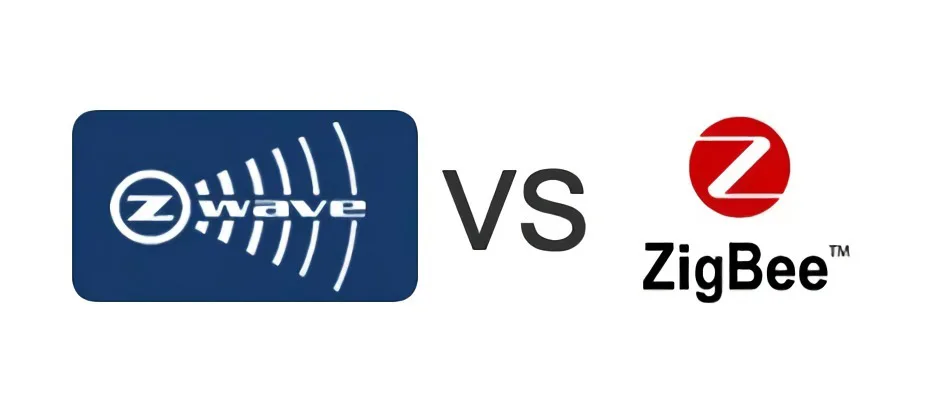Z-wave 是指許多智慧家庭設備所使用的無線電系統. Smart home is essential technology of the 21st century that can help you always to connect one end of your home system to the other. The Z-Wave and ZigBee technologies are two major standards that can be used for smart devices, 智慧照明, 自動化控制, heating and security equipment.
什麼是 Z-Wave 技術?

Z-wave 最初開發於 1999 由一家名為 Zensys 的丹麥公司開發. 這是一個簡單的, 家庭自動化系統的經濟且多功能的替代品. 發展至今, 並迅速獲得了超過 700 家用電子品牌和公司, 比如華為, ADT, 三星智能, LG, 通用電氣, 八月, 中芯國際, 和英格索蘭. 現在, 有超過 2,600 市面上各種 Z-Wave 認證產品, 一切都是為了互通而建構的.
How does Z-Wave work?

Z-wave 網路專門用於鏈接 智慧家庭 裝置和智慧集線器. Z-wave 技術應用於智慧開關, 恆溫器, 感應器, ETC. 它可以連接適當大小的房屋內的設備, 儘管它比普通藍牙和 Wi-Fi 消耗的電量少得多.
喜歡Zigbee技術, Z-Wave 使用網格拓撲連接到設備. This implies that rather than every device having to directly link to a router or hub, devices using the Z-Wave technology can transmit data packets to and fro between the devices. 所以, when the distance between a Z-Wave bulb and hub is large, the signal can still transmit to its desired location, passing through the sensors and the devices.
This arrangement makes Z-Wave more flexible, even slightly slower than Wi-Fi. Its network range grows significantly when many Z-Wave devices are installed. 而且, the installment of many devices makes the Z-Wave technology more robust as there are many techniques for transmitting data packets from one point to another.
Z-Wave VS Zigbee

The operating frequencies of Z-Wave range from 800 到 900 兆赫茲, whereas Zigbee can even fully function at 2.4 百萬赫. This implies that devices enabled with Z-Wave have a much lower rate of data transmission than devices enabled with ZigBee. 另外, Z-wave supports lower data transmission of 9.6-10 KBPS, whereas Zigbee can support transmissions of up to 250 KBPS.
儘管如此, Z-Wave devices have a very small possibility of external interference, whereas Zigbee devices have a more significant possibility. Z-wave and Zigbee technologies add devices to their networks by implementing mesh network topologies. Only less than 232 devices can be supported in a Z-wave network, but Zigbee networks can support over 65,000 裝置. In the case of a homeowner, having even 232 units is more than enough needed to run a home entirely.
The AES 128-bit encryption is used securely with no hacking in both Z-Wave and ZigBee networks. With absolute security being a contradiction, it is essential to realize that both networks adopt similar methods to end-user security. 另外, the range of Z-Wave devices is about 30 米, whereas Zigbee devices have a limited range of fewer than 20 米.
除了, it is essential to know that the Zigbee Consortium runs and manages the available standard Zigbee technology, whereas the Sigma devices company privately owns the Z-Wave technology. Hence they have tighter controls that guarantee device compatibility with many controllers.
Z-Wave VS Wi-Fi

The benefits of Wi-Fi for automation
Wi-Fi has multiple advantages when used for home automation. Wi-Fi devices can be placed anywhere in a room without worrying about tripping over the ropes required to run. Systematizing with a Wi-Fi network can help free up router ports for those other devices when one or more devices are router-hardwired.
Home automation systems based on the Wi-Fi network are as dependable as 無線網路. Automation reduces whenever a Wi-Fi network frequently goes down.
The benefits of Z-Wave for automation
On the question of whether Z-Wave is more suitable for automation than Wi-Fi? Believe it or not, it is easier to set up a Z-Wave network than Wi-Fi as there are no worries about it meddling with a home Wi-Fi signal.
Most Z-Wave devices can directly and quickly add new devices to a home system as they can automatically detect each other. 而且, the Z-Wave network is more flexible, and thousands of various devices can run on Z-Wave frequencies. 因此, it is easier to establish the best device for your necessities.
Compatibility is one more thing the Z-Wave network can’t contest with Wi-Fi. Devices using the Z-wave network are backward compatible. 因此, older devices are compatible with the present system, and any new devices developed are expected to be compatible with the already existing Settings.
Z-wave is automated with Wi-Fi.
Home automation systems can be set up using both Z-Wave and Wi-Fi networks. From security systems to smart appliances to lighting and garage door openers, both networks can be used to connect to nearly any electronic device.
If your home already has an existing Wi-Fi network, no extra setup or cost is required. Wi-Fi-enabled home automation devices are cheaper than Z-Wave-enabled devices, although various problems arise when too many devices are connected to a Wi-Fi network simultaneously.
Z-wave systems are costlier, but they eliminate issues relating to interference as they work at a relatively different wavelength than Wi-Fi signals.
What devices use Z-Wave?

The Z-wave technology was initially designed for wireless control of smart homes, concentrating on business and residential lighting control. It changes some stand-alone devices to smart networking devices, thus facilitating wireless control and monitoring. The Z-Wave technology is extensively used for smoke detectors, 遙控, lighting control, security and climate control, appliances, 門鎖, and security sensors. 而且, it can also be used in smart meters to offer the data consumption rate for home HVAC monitoring.
How secure is Z-Wave technology?

The Z-Wave network is indeed very secure. It assigns every device a unique network ID. Since every control system has a different ID that is automatically controlled, no external party can control the devices.
Whenever an extra security level is required, 例如門鎖和其他安全裝置, Z-Wave 使用更先進的 AES128 加密技術來保護設備的數據. 在 Z-Wave 網路上運行的大多數產品都使用 Z-Wave AES 加密方法.
Introduction to Z-Wave communication protocol
短控制資料在節點單元之間一致傳輸. 從下到上, 其協定分為五層: 物理層, MAC層, 傳輸層, 路由層, 和應用層. MAC層的作用是建立, 維持, 並終止設備之間的任何無線資訊連接. 共, 它執行幀驗證, 控制通道訪問, 並預留時段管理.
媒體層採用碰撞避免機制 (CSMA鱷魚CA) and carrier sense multiple Access to enhance the dependability of data transmission. It also stops other nodes from transferring signals when nodes are available to share information. 另一方面, the transport layer is primarily used to offer consistent data broadcast between nodes. Its key roles are; frame verification, retransmission, flow control, and frame verification.
The routing layer controls the data frame’s routing between nodes. 也, it makes sure that data frames can be transferred repetitively among various nodes, scans the topology of a network, and maintains the routing table. The application layer is liable for the instruction execution and decryption in the Z-Wave network. Its primary roles are; HomeID and No ID assignment, Manchester decoding, network controller replication, instruction recognition, and payload control for received and transferred frames.
Introduction of Z-Wave frequency
The physical layer
Z-wave is a wireless technology that emphasizes on application of low-rate. Its rates of transmission are between 9.6kbit /s and 40Kbit/s. The prior is more than satisfactory for transferring control commands, while the latter can offer more advanced network security mechanisms. It has a flexible operating frequency band in the ISM band of 900MHz, 908.42MHz in the United States, and 868.42MHz in Europe. Only relatively few devices effectively operate in these bands.
Zigbee and Bluetooth use the 2.4GHz band, which is becoming progressively crowded, and the intrusion is unavoidable. 所以, the Z-Wave technology warrants reliable communication, although its power consumption rate is relatively lower. It incorporates a Frequency-Shift Keying (FSK) mode of wireless communication that is more suitable for smart home networks. Nodes powered on batteries are primarily kept in a sleep-mode state, where they frequently wake, to monitor if there is any information it needs to receive. The nodes use two ordinary No. 7 batteries lasting up to 10 年.
It ensures the application has long-term stability, thus enabling the user to evade the concern of recurrent charging and replacing the electric pool. Z-Wave has a less complex system than ZigBee and is smaller than the Bluetooth network. It requires small storage, and its protocol is simple. The protocol of a standard Z-Wave module is captured by an in-built 32KB flash memory, whereas the same ZigBee module needs about 128KB to use. Bluetooth requires a relatively big module. 因此, Z-Wave modules are less costly than ZigBee or Bluetooth modules.
The Z-Wave network supports a maximum of 4 level routes and has a single capability of about 232 節點, far less than ZigBee’s 65,535. Z-Wave cannot build large-scale networks in a universal application compared to ZigBee. 也, the Z-Wave network can use virtual node technology to communicate with other kinds of networks.
The MAC Layer
The MAC layer controls the wireless medium in the Z-wave network. The Manchester coding is adopted by the data stream, which consists of the frame head, frame tail, frame data, and preceding code. Frame data comprises a frame part that is passed to the transport layer. All information is transmitted through a little-endian mode.
Although the MAC layer is autonomous of the wireless frequency, medium, and modulation technique, it necessitates that the complete binary signal or the frame data is easily obtainable from the Manchester encoded or decoded bit streams when receiving information. An 8-bit data block is used to transmit data. The Most Significant Bit (MSB) is the first Bit of data to be transmitted. The data is encrypted in Manchester to attain a DC-free signal.
In the MAC layer, a conflict avoidance mechanism prevents nodes from transferring information when other nodes send data. The collision avoidance mechanism is implemented by putting nodes that are not transferring information into receive mode and suspending communications in case the MAC layer is in the receiving phase. All kinds of nodes have an active collision avoidance mechanism. Frame transmissions are always delayed by a few milliseconds whenever the medium is busy.
The CSMA/CA forms the core of the MAC collision avoidance mechanism. The CSMA/CA comprises three mechanisms; the inter-frame interval, carrier listening, and random backoff. Every node uses the distributed Access algorithm of Carrier Sense Multiple Access (CSMA) to make it fully complete for the channel to attain the transmission accurately. The ACK (Acknowledgement) mechanism or the twice-handshake mechanism is used in the CSMA/CA mode. The ACK frame is immediately sent whenever the receiver obtains the correct frame. The frame is successfully sent when the sender receives the Acknowledgement frame.
Data is transmitted in a delayed transmission when the frame interval is smaller than or equal to the media idle time. The carrier listening mechanism forms the basis of CSMA/CA. Physical carrier monitoring is done at the physical layer by sensing the antenna’s valid signals. The detection of valid signals shows that the physical carrier monitoring has considered the channel busy. 而且, MAC carrier monitoring is accomplished at the MAC layer by sensing the MAC frame’s inter-tenacity domain.
Information is broadcasted only when there is an idle channel. A busy channel executes the backoff algorithm where the channel is redetected to evade crashes between the media shared. Multiple nodes are waiting for the medium. All nodes send data when the medium is idle, thus leading to multiple collisions. 因此, CSMA/CA controls the sending of frames of every node using the random backoff time.
The transport layer
The transport layer is used to transmit reliable data between nodes. It comprises frame verification, flow control, retransmission, and frame confirmation. 而且, the transport layer is consists of three types of frames. 他們是;
Unicast frame – It is directed to a definite node. The Unicast frame replies with an ACK reply frame when the target node effectively receives the frame. 另一方面, the Unicast frame is resent once damaged or lost. The retransmission frame encounters random delays to evade collisions with other systems. The unexpected delay should always be constant with the maximum length of the frame transferred and the duration taken to obtain the reply frame. Unicast frames also optionally switch off the reply mechanism in systems that don’t need a dependable transmission. A reply frame is a kind of unicast frame in the Z-Wave network with a data field of length O.
Multicast frames – Multicast frames are transferred in the network from nodes 1 到 232. The multicast frame destination specifies all destination nodes without transmitting a discrete frame to every node. Multicast frames cannot be used in systems that need reliable communications as they do not respond actively. When multicast frames need dependability, unicast frames should follow them.
Broadcast frame – The broadcast frame is transferred to all network nodes. The frame does not receive a response from any node. Similar to the multicast frame, the broadcast frame cannot be used in systems that need reliable communication. 而且, the broadcast frame must be followed by a unicast frame in case the broadcast frame requires dependability.
Z-Wave Solutions
Devices like printers, 桌上型電腦, 筆記型電腦, and microwaves consume power even when they are not in usage, thus representing almost 20% of all monthly energy bills in a home. It is constantly hard to switch off the thermostat when moving out of the house. Z-Wave products can help you quickly go green as they are built to save energy and cost at your home daily.
Z-wave products are different from the rest as they interact via a cohesive 網狀網路 that permits the access and connection of all devices through a single portable application. Using an application that carefully manages your whole smart home, you can switch off all devices that consume more energy in less than a second from almost any location. Some of the ways the Z-Wave technology can be used to minimize energy bills in homes are;
- 智慧照明 – Shift to lighting that detects motion to inhibit lights from consuming power when everyone is away. You can establish a lighting program that automatically switches the lights on and off depending on the time of day. 另外, you can automatically adjust the brightness of your lights using light sensors.
- Smart Thermostat – A mobile phone can be used to control a smart thermostat. It can be used to save energy when away from the house efficiently and automatically switch it on before getting home. The smart thermostat automatically turn offs when the window is open, thus making sure that no unnecessary energy is used. These thermostats mechanically self-regulate based on the smart hub’s temperature Settings, so the user has no worries about switching the thermostat on and off.
- Smart Plugs – Smart plugs use the Z-Wave network and offer dyed rings on the exterior and colour changes based on energy usage levels to enable the user to monitor the usage. A smart plug automatically switches off every time there is overwork in energy usage. Energy-wasting devices and all power-consuming technological products can be controlled using smart plugs by switching them off whenever they are not in use.
The History of Z-Wave
The Z-wave technology was developed by a Danish company known as Zensys. Two Danish engineers established the company in the late 1990s. Zensys has grown from creating home automation solutions to being a provider of technical communications. The company offers technical support to enterprises designing solutions for interoperable control. Vendors worldwide recognize the Z-wave technology for its interoperability and reliability, thus building the largest compatible ecosystem.
The Zensys company brought the first hardware into the market in 2003. It combined a standard transceiver and a microcontroller (愛特梅爾). The expansion of this hardware platform has led to the growth of subsequent chip generations 100 (2003), 200 (2005), 300 (2007), 400 (2009) and the latest 500 (2012).
Another milestone in the history of Z-Wave was realized in 2005 after the formation of the Z-Wave Alliance. This alliance aims to gather companies that manufacture products compatible with the Z-Wave technology. 經過 2008, 超過 100 manufacturing companies had joined the alliance. The Z-Wave Alliance has increasingly sustained to improve the standards and manage global promotional events like trade shows.
The Z-Wave Consortium is also responsible for retaining the interoperability of several devices based on the Z-Wave protocol. This is attained through establishing a critical verification system and a valuable pre-packaged source code base to ensure that the devices pinned with a Z-Wave logo meet the 3 requirements of the Z-Wave Alliance. These requirements are; excellent efficiency, compliance with specifications of the communication protocol, and reliable user experience.
Market State for Z-Wave Products
The US market is the largest target for Z-wave products. Over 70% of those using Z-Wave products are from the United States, while the other 25% are in Europe and 5% are based in China. With the US being a comparatively developed nation, many individuals in the country have promptly embraced the Z-Wave technology. This is because most houses in American cities are big; hence it is challenging to move from one room to the other, switching off the lights.
而且, since the United States is a big country, safety is its primary concern; hence they have very mature security system services. In security enterprises, the security downstream and upstream of the whole chain are perfect, irrespective of whether it is a construction, product, or after-sales service. 基於此, smart home systems can enhance significant enactments for security enterprises. Smart homes are more prevalent in the United States as people living there are more than happy to embrace this new technology in their homes.
















